
Concerns about battery life are among the most critical issues facing wearable and wireless tech owners. Battery life limitations, when your smartwatch dies at noon, the earbuds die during your workout, or the fitness tracker dies before the end of the day, are critical because you want to maximize your use of a device that works until it runs out of power. This guide provides professional tips and tricks for getting extra life out of your smartwatch, earbuds, and fitness tracker, whether you are an infrequent user or a consumer willing to try new strategies where technology is concerned. By optimizing your usage, you can reduce fuss and extend the life of wearable and wireless tech between charges.
We will examine practical methods, pro hacks, and preventative habits for prolonging the life of your favorite wearables. As a bonus, you’ll also discover battery-life habits for increasing the running time of your robot vacuum and using clever battery tricks with other portable electronics like tablets.
Before we get into specific tips, let’s take a moment to explain why optimizing battery consumption on your wearables and wireless devices is essential:
Whether you disable/reduce background functions or alter your sync settings, even minor modifications can yield big wins.

Most smartwatches have an always-on or auto-brightness setting. Turning off the always-on display and manually lowering brightness can dramatically extend battery life.
How to do it:
Smartwatches constantly pinging for social updates, texts, and emails drain battery quickly. Disable non-essential notifications and only allow alerts from priority apps.
Pro Tip: Customize notifications by app using your smartwatch companion app.
Wi-Fi and GPS are high-drain features. Unless you’re navigating or downloading apps, turn them off.
Most smartwatches now include built-in power-saving modes. These turn off non-critical functions and reduce refresh rates.
Example benefits:
This is one of the best tips to save battery on a smartwatch, especially when you're away from a charger.
Heart rate monitors, SpO2, and ambient light sensors continuously draw power. Turn off or limit tracking frequency for better efficiency.
You can only update firmware when you need to. New updates sometimes bring battery optimizations, but can temporarily increase power drain due to background indexing.
Use just one earbud for tasks like phone calls or podcasts. This allows the other to rest and preserve charge, doubling your use time.
Higher audio volumes require more battery power due to increased power sent to the drivers. Keeping your earbuds at 50–70% volume can significantly extend wireless earbuds' battery life.
Active Noise Cancellation (ANC) is a power-intensive feature. You can use it only when necessary, like on flights or in noisy environments.
A low-charge case can affect earbuds’ performance. Keep your charging case regularly topped up to ensure fast and full recharges.
Dirt or earwax buildup can prevent proper charging. You can use a microfiber cloth or a cotton swab to clean the metal contacts.
Let the earbuds deplete to 20–30% before recharging. Continuous top-ups can reduce long-term battery health.
Most fitness trackers allow you to choose how often data is collected. For example, recording heart rate every minute drains more power than recording every 10 minutes.
Animated or complex watch faces consume more energy. To extend the fitness tracker battery, use a minimalist watch face without moving elements or bright colors.
Fitness trackers often default to showing the time when you raise your wrist. Turning off “always-on” screens gives a significant battery boost.
Please turn off real-time syncing unless you need to. Manual sync once or twice daily is sufficient for most users and saves considerable battery.
Voice assistants or gesture controls are convenient but power-hungry. You can disable them unless you use them regularly.
Enable exercise tracking only during workouts. Leaving it on all day will exhaust your battery fast.
These bonus hacks can be applied to your smart home gear, earbuds, and wearables. They can even help increase robot vacuum runtime and offer tablet battery hacks.
This turns off most communications and tracking. Ideal during long meetings, flights, or sleep.
High heat or extreme cold degrades battery cells. Never leave devices in direct sunlight or freezing cars.
Aim to charge devices between 20% and 80% battery. This charging method is healthier for lithium-ion batteries.
Vibration and notification sounds use extra energy. Disable or minimize them in settings.
Battery life is often improved with newer firmware or OS updates, but always review patch notes to be sure.
Whether on a smartwatch, tablet, or vacuum, background processes can cause unwanted battery drain. Limit active background apps via device settings.
Like your fitness, your device’s battery performs better with good long-term habits.
Although overnight charging may be convenient, it can heat your battery unnecessarily. You can use timed chargers or smart plugs with scheduled cut-offs.
Third-party accessories can lead to slow or inconsistent charging, which damages battery cells over time.
Once every 2–3 months, let your device drain and recharge. This recalibrates battery indicators for more accurate readings.
On OLED and AMOLED screens, black pixels are turned off completely, using significantly less energy than bright themes.
Don’t wait until you're at 10%. Enabling battery saver modes at 30–40% gives you more control and runtime flexibility.
| Device Type | Key Battery Tips |
| Smartwatch | Reduce brightness, limit GPS, and use power-saving mode |
| Earbuds | Lower volume, turn off ANC, clean contacts regularly |
| Fitness Tracker | Adjust tracking frequency, simplify the watch face, and turn off intelligent assistants. |
| All Devices | Avoid extreme temps, strategic charging, and turn off unnecessary features |
Extending battery life does not need to be a drastic change. With a few simple tweaks, your wearables and wireless devices can work longer, more reliably, and with fewer interruptions. These professional tips to extend the battery life of your smartwatch, earbuds, & fitness tracker can also be used for batteries on other portable devices—from robot vacuums to tablets—making your entire tech stack more effective.
So the next time you're annoyed by a dead device during your workout or Zoom call, please look at this guide. A couple of changes can convert a short battery life into all-day endurance.
This content was created by AI